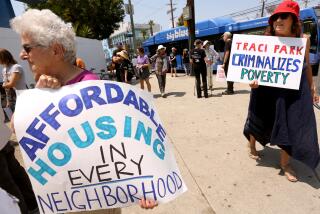Society’s Ills Put Burden on City Hospitals, Report Says : Social services: Rising crime rate, homelessness and AIDS contribute to decay in system, a coalition of urban health-care institutions says.
- Share via
Social ills that were inadequately addressed in the 1980s have turned urban hospitals into “catch-all social services agencies,” crowded with victims of AIDS, drugs, gang violence and the ravages of homelessness at a time when hospitals can least afford to expand their traditional role, a coalition of urban hospitals reported today.
The coalition--the Urban Health Issues Group of the Conference of Metropolitan Hospital Assns. (CMHA)--called for coordinated efforts by public agencies and political leaders to help alleviate the burden on hospitals. The alternative is continued decay of the urban hospital system, as evidenced by the closing of trauma centers and curtailment of other services by financially strapped hospitals.
“People see the rising crime statistics, they hear about the problem of homelessness,” said Allan N. Johnson, chairman of the Urban Health Issues Group and an author of the report. “What they don’t understand is the linkage between these social problems and increased health care costs for which there is no one around to pay.”
The report, titled “The Health of 1990 Urban America,” was written to quantify the effect of these social ills on the health care system in hopes of finding solutions. The report is being distributed today to members of Congress and political and civic leaders in the 35 metropolitan areas whose hospitals form CMHA.
Johnson said the coalition’s next step will be to sponsor a series of seminars in Washington for congressional and community leaders.
The study relied on data from hospitals in the nation’s major urban centers, including Los Angeles, New York, Chicago, and Washington. San Francisco and San Diego hospitals also contributed.
Among the report’s findings:
Acquired immune deficiency syndrome has grown from 295 cases reported to the federal Centers for Disease Control in 1981 to an estimated 57,000 new cases this year. Most of the cases tend to be concentrated in urban areas, with a disproportionate impact on the hospital system. For example, in New York, nearly 10% of the hospital beds are filled by AIDS patients, few of whom have health insurance.
More addicted mothers mean more babies born with the consequences of addiction, including low birth weight, physical deformities, mental limitations and inadequate development. At Hutzel Hospital in Detroit, where 7,000 of 20,000 babies born in the city are delivered, random testing of mothers and babies showed that nearly 40% were exposed to cocaine or heroin during the pregnancy.
The U.S. rate for violent crime rose 16% during the 1980s; the victims inevitably end up in the nation’s hospital emergency rooms. Los Angeles has the worst problem, with the highest rate of gang- and drug-related violence, according to David Langness of the Hospital Council of Southern California. The volume of violence-related injuries, combined with inadequate payment for the medical care required, led four hospitals in Chicago to drop out of the trauma network and has contributed to the closure of seven hospitals there since 1985, according to the report. In Los Angeles County, 13 of 23 hospitals have pulled out of the trauma system.
Hunger, malnutrition and exposure to harsh weather drive many homeless Americans to hospitals for medical care as well as shelter, food and warmth. In Los Angeles, Ronald Dahlgren, president of Queen of Angels-Hollywood Presbyterian Medical Center, says he regularly sends memos to the staff asking for contributions of clothing for homeless patients about to be discharged back to the streets. “We are not just talking adult males, but also women and children,” Dahlgren said. “Some of their health problems resulted directly from inadequate protection against the cold.”
An estimated 37 million Americans lack health insurance or other means to pay for their health care, a 22% increase since 1981. In Los Angeles County, one in four cannot pay. The inability to pay prompts people to put off low-cost preventive health care and places a greater burden of serious illness on hospitals. Between 1980 and 1988, the burden of uncompensated hospital care grew from $3 billion to $8.3 billion, according to the report.
More to Read
Sign up for Essential California
The most important California stories and recommendations in your inbox every morning.
You may occasionally receive promotional content from the Los Angeles Times.













